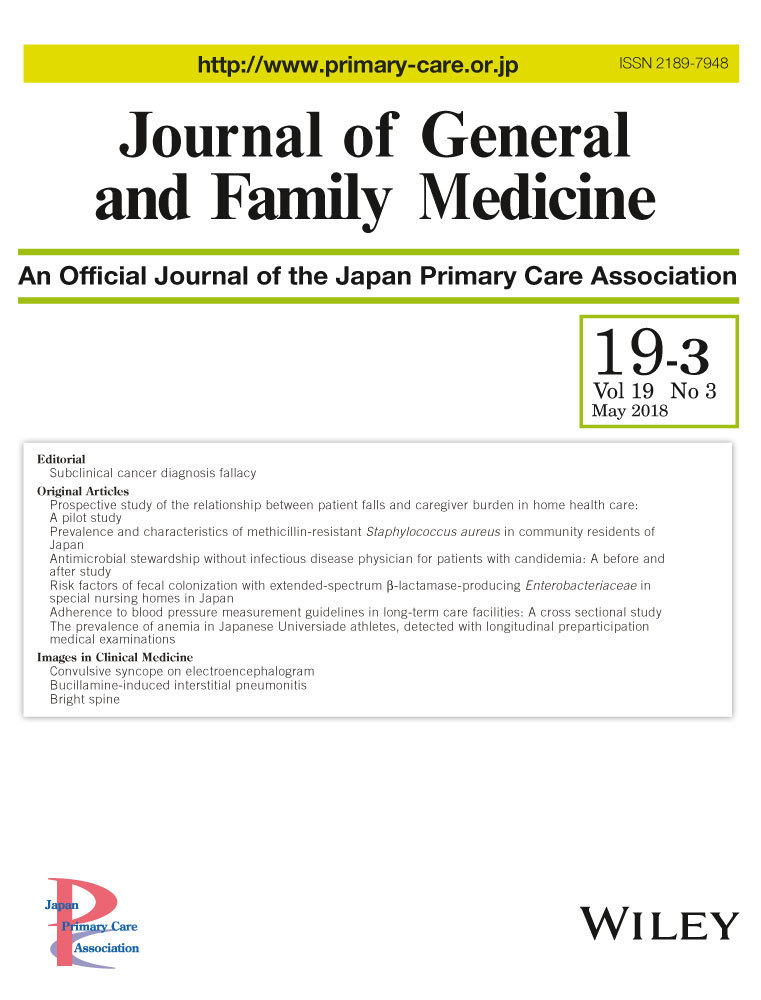The prevalence of anemia in Japanese Universiade athletes, detected with longitudinal preparticipation medical examinations
Abstract
Background
No reports have evaluated the long-term trends of the prevalence of anemia in Universiade athletes using preparticipation medical examinations (PPMEs). We aimed to investigate the prevalence of anemia among Japanese Universiade athletes, using longitudinal PPMEs.
Methods
In this retrospective, observational study, athletes with published data from official reports of the Japanese delegation of the summer Universiade games between 1977 and 2011 were included, as were similar-aged nonathletes with published health data, extracted from official national reports from the Japanese Ministry of Health, Labour and Welfare. PPME data and national health survey data included blood tests for anemia and the age of each participant. We compared the anemia prevalence in both groups using an unpaired t test.
Results
Anemia prevalence among Universiade athletes decreased by 11.6% over the study period (13.3% in 1977 to 1.7% in 2011). Moreover, anemia prevalence between 1991 and 2011 in the total Universiade athlete population was significantly lower than that in the nonathletic population (mean ± standard deviation: 5.2 ± 2.9% vs 9.8 ± 1.5%, respectively; P = .025). In female Universiade athletes, anemia prevalence between 1977 and 1981 was higher than that in the nonathletic populations (48.1% vs 19.7%, respectively). However, in 2003, this value was lower than that in nonathletic female populations (8.5% vs 19.8%, respectively).
Conclusions
A decrease in anemia prevalence in Japanese Universiade athletes was revealed with longitudinal PPMEs. Hematological parameters should be evaluated longitudinally in athletes to provide continuous performance support throughout the athlete's career.
1 BACKGROUND
1.1 Preparticipation medical examinations (PPMEs)
Preparticipation medical examinations, otherwise known as periodic health evaluations (PHEs), are encouraged and widely used for health screening in elite athletes. The International Olympic Committee (IOC) published a consensus statement on PHEs for elite athletes in 2009.1 The main purpose of PPMEs is to screen for injuries and disorders such as cardiovascular abnormalities in athletes, which may limit their ability to safely participate in sporting events.1 The other purpose is to ensure that current health problems that deteriorate an athlete's performance, such as anemia, are managed appropriately. Ultimately, PPMEs are used to determine whether an athlete is medically capable of engaging in a particular sports event.1 According to the IOC statement, PPMEs have been introduced worldwide as a standard procedure to detect rare and serious diseases as well as common conditions that may influence an athlete's daily performance.1 However, there is insufficient evidence to demonstrate the usefulness of PPMEs for monitoring the prevalence of anemia among elite athletes.
1.2 The prevalence of anemia among athletes
Anemia is an important disease in athletes because the hemoglobin (Hb) concentration in the peripheral blood is strongly related to physical performance.2 Iron deficiency anemia, in particular, causes easy fatigability and decreased performance in athletes. The prevalence of iron deficiency anemia among elite athletes in the United States is approximately 3%, which is similar to that of untrained individuals.3 The prevalence of anemia in the general Japanese population was first reported in 1947 in a national survey.4 However, the diagnosis of anemia at that time was based only on physical examinations such as checking the palpebral conjunctiva and color of the nail. The prevalence of anemia based on a hematological test was reported for the first time in 1972. In people aged 18-24 years, the prevalence of anemia was 15.1% and 25.5% in men and women, respectively.4 Subsequently, in a national survey of the general Japanese population, the prevalence of anemia was investigated annually. However, there are no available data regarding the trends in the prevalence of anemia among Japanese Universiade athletes using PPMEs, and in this study, we aimed to elucidate these trends using this data.
2 MATERIALS AND METHODS
2.1 Participants
2.1.1 Universiade athletes
In this retrospective, observational study, we collected data on Universiade athletes from official published reports of the Japanese delegation for the summer Universiade games between 1977 and 2011 (18 competitions in total).5-20 Although the summer Universiade games have been held annually since 1957, there are no official published reports of the Japanese delegation between 1957 and 1975. We collected information on the published number of participants and the number of anemic Universiade athletes to calculate the prevalence of anemia. All published data were prepared based on data from PPMEs. All Universiade athletes were between 18 and 22 years old.
2.1.2 Nonathletic population
The prevalence of anemia in the nonathletic population (as a control group) was determined based on data from The National Nutrition Survey (1977-2002), The National Health and Nutrition Survey (2003-2011), and official national reports by the Ministry of Health, Labour and Welfare in Japan.4 These surveys were performed every November to understand the health status, nutritional intake, and lifestyle habits among nonathletes and to obtain the basic data necessary to promote comprehensive health in Japan.4 These annual surveys included between 15 000 and 20 000 household members from the general public from 5000 to 6000 households in 300 unit districts. Survey participants were selected using stratified random sampling from each unit district, as set by The National Livelihood Survey of the Ministry of Health, Labour and Welfare. Unit districts were geographically split from census districts by the Statistics Bureau and the Ministry of Internal Affairs and Communications.
According to The National Nutrition Survey and The National Health and Nutrition Survey, households or individuals meeting the following exclusion criteria were not accepted for the survey: non-Japanese head of household, households receiving collective meals, one-person households with access to catering or living in a dormitory, persons younger than 1 year old, homebound patients who could not eat normal meals because of disease, household members who did not eat together, bachelors, migrant workers, long-term business travelers (residing in Japan for more than 3 months), leisure educators, social welfare facility residents, long-term hospital patients, foster children, inmates or estranged partners. All subjects completed questionnaires that were composed by the investigators, who included a doctor, public health nurse, and clinical laboratory technician.
In these subjects, blood tests were only performed on participants 20 years of age or older. Blood was collected from the cubital vein, with the participant in a seated position, at least 30 minutes after breakfast. Between 1991 and 2011, the prevalence of anemia was calculated for six age groups in 10 year intervals: 20-29, 30-39, 40-49, 50-59, 60-69, and over 70 years old. Because the data are available online for public inspection,4 we collected survey data from the 20- to 29-year-old group as the study population for the nonathletic group. Similarly, between 1977 and 1989, survey participants were classified into age groups, as follows: 18-24, 25-29, 30-39, 40-49, and 50-59. For that period, we collected data from the 18- to 24-year-old group.
2.2 Preparticipation medical examinations
The Japan Sports Association (JSA) conducted PPMEs between 1956 and 1989. After the Japanese Olympic Committee (JOC) was created by the JSA as an independent organization in 1989, they assumed responsibility for PPME administration. The evaluation components of the PPME are as follows: inquiry (including whether the athlete is being treated for anemia), physical examination (including internal medicine and orthopedics), electrocardiogram, chest X-ray, general urine test, and blood tests (including complete blood counts, blood chemistry, and thyroid function). However, past official published reports of the Japanese delegation did not describe the results of each item, especially detailed ferrokinetic information. All Universiade athletes received PPMEs prior to competition. Considering the possible impact on their performance, the evaluators conducted the PPMEs in the morning after the athlete ate breakfast, without any imposed movement restrictions up to the previous day. Blood was collected from the cubital vein with the athlete in a seated position. PPMEs were performed by doctors from the National Federation or the Japan Institute of Sports Science.
2.3 Statistical analysis
In each published report, anemia was defined as an Hb concentration of <14 g/dL for men and <12 g/dL for women. This cutoff has been used routinely in national official reports in Japan. We compared the prevalence of anemia in Universiade athletes (the total number of anemic athletes/total number of athletes × 100) with that of nonathletes (the total number of anemic nonathletes/total number of nonathletes × 100) using an unpaired t test. All statistical tests were two-tailed. The statistical analyses were conducted using SPSS statistics version 23® (IBM, New York, NY, USA). P-values <.05 were considered statistically significant.
2.4 Ethical considerations
All Universiade athletes were educated regarding the necessity of PPMEs and provided informed consent for the utilization of all results for official published reports before the PPME was initiated. Likewise, nonathletic participants were also informed of the necessity of The National Nutrition Survey (1977-2002) and The National Health and Nutrition Survey (2003-2011) by the investigator and provided informed consent before inclusion in the investigations. We obtained permission to use data from the JOC and the Ministry of Health, Labour and Welfare. Because all data have already been published, ethics committee approval was not required. We also conducted this study in accordance with the ethical principles of the Helsinki Declaration of 1975, as revised in 1983.
3 RESULTS
3.1 Participants
We investigated 18 official published reports of the Japanese delegation for the summer Universiade games and the national surveys of the corresponding year for each competition. According to the reports from the Universiade games, the number of participants increased fourfold between 1977 and 2011, even though there were missing data for male and female participants in 1985, 1997, and 2009 (Table 1 and Figure 1).
| Year | Universiade athletes | Nonathletic populations (%) | |||||||
|---|---|---|---|---|---|---|---|---|---|
| Participants (N) | Anemic athletes (%) | ||||||||
| Total | Male | Female | Total | Male | Female | Total | Male | Female | |
| 1977 | 98 | 71 | 27 | 13.3 | 0 | 48.1 | N/A | N/A | 19.7 |
| 1979 | 112 | 85 | 27 | 10.7 | 0 | 44.4 | N/A | N/A | N/A |
| 1981 | 98 | 74 | 24 | 9.2 | 1.4 | 33.3 | N/A | N/A | N/A |
| 1983 | 143 | 91 | 52 | 9.8 | 4.4 | 19.2 | N/A | N/A | 14.4 |
| 1985 | 264 | N/A | N/A | 4.5 | N/A | N/A | N/A | N/A | N/A |
| 1987 | 156 | 112 | 44 | 11.5 | 10.7 | 13.6 | N/A | N/A | N/A |
| 1989 | 49 | 38 | 11 | N/A | N/A | N/A | N/A | N/A | N/A |
| 1991 | 179 | 114 | 65 | N/A | N/A | N/A | 9.7 | 3.6 | 13.7 |
| 1993 | 171 | 106 | 65 | 6.4 | 0.9 | 15.4 | N/A | N/A | N/A |
| 1995 | 275 | 174 | 101 | 2.2 | N/A | N/A | 7.9 | 3.5 | 10.5 |
| 1997 | 153 | N/A | N/A | 9.2 | N/A | N/A | 10.1 | 4.0 | 13.6 |
| 1999 | 175 | 109 | 66 | 5.7 | N/A | N/A | 11.6 | 5.1 | 14.8 |
| 2001 | 210 | 144 | 96 | 2.4 | N/A | N/A | N/A | 5.1 | 13.1 |
| 2003 | 239 | 133 | 106 | 4.2 | 0.8 | 8.5 | 17.1 | 13.1 | 19.8 |
| 2005 | 281 | 152 | 129 | 8.2 | 5.9 | 10.9 | 7.8 | 2.6 | 11.8 |
| 2007 | 310 | 161 | 149 | 3.2 | N/A | N/A | 8.3 | 4.5 | 11.2 |
| 2009 | 294 | N/A | N/A | 5.1 | N/A | N/A | 13.6 | 6.7 | 18.1 |
| 2011 | 403 | 230 | 173 | 1.7 | N/A | N/A | 10.1 | 2.7 | 14.4 |
- N/A, not available.
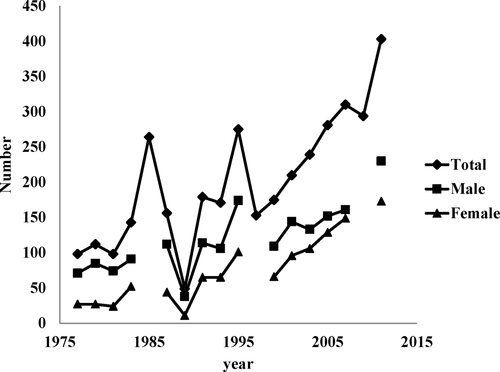
Regardless of the increase in the number of participants, the number of anemic athletes remained the same, which indicates that there was a lower anemia prevalence rate in the total Universiade athlete population in 1977 than in 2011 (13.3% and 1.7%, respectively) (Table 1 and Figure 2).
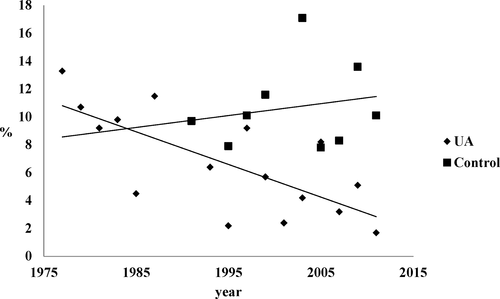
There was no information regarding the number of athletes already undergoing treatment for anemia. However, some reports included detailed information on the treatment of anemia that was detected by PPMEs. In 1977, 3 of 10 athletes with a low Hb concentration (8.3 g/dL, 8.5 g/dL, and 9.2 g/dL) were prescribed iron tablets. In 1979 and 1981, all anemic athletes were prescribed iron tablets. In 1983, one volleyball player and one gymnast were each prescribed iron tablets. In 1985, one athlete with an Hb concentration of 7.1 g/dL was prescribed iron tablets. In 1987, iron tablets were prescribed for all anemic athletes, regardless of Hb concentration. In 1997, one female high-jump athlete was treated with iron supplementation. Finally, in 2011, all anemic athletes were treated with iron tablets. Conversely, no reports on the nonathletic population addressed the treatment of anemia, except for the 2011 survey, which stated that no subject was treated for anemia.
3.2 Comparison of the prevalence of anemia
Compared with the nonathletic population, the prevalence of anemia in Universiade athletes clearly improved between 1977 and 2011 (Figure 2), although there were some missing data between 1977 and 1989 in the nonathletic population. The prevalence of anemia between 1991 and 2011 in the total Universiade athlete population was significantly lower than that in the nonathletic population (mean ± standard deviation: 5.2 ± 2.9% vs 9.8 ± 1.5%, respectively; P = .025). The prevalence of anemia in male Universiade athletes did not change throughout the study period, except in 1987 (Figure 3). In female athletes, the prevalence of anemia in 1977 was higher than in the nonathletic population (48.1% vs 19.7%, respectively). Conversely, in 2003, it was lower in athletes than in the nonathletic population (8.5% vs 19.8%, respectively). However, the prevalence of anemia in female Universiade athletes between 1977 and 1983 was not statistically significant compared with that of the nonathletic female population (36.3 ± 13.0% vs 17.1 ± 3.7%, respectively; P = .124). Moreover, the prevalence of anemia between 2003 and 2011 was also not statistically significant (female Universiade athletes: 9.7 ± 1.7% vs nonathletic female population: 15.1 ± 3.8%; P = .055) (Figure 4).
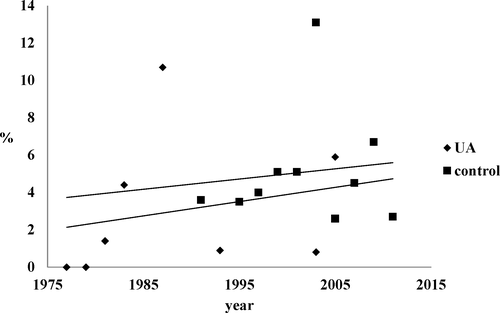
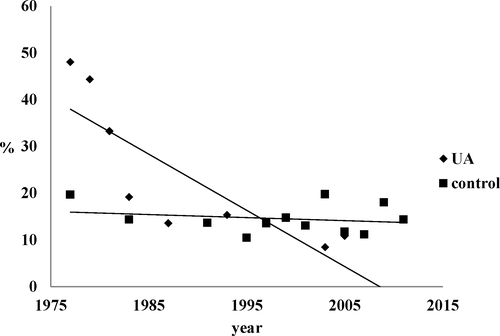
4 DISCUSSION
4.1 The prevalence of anemia
This study clearly demonstrates that there was a higher prevalence of anemia in female Universiade athletes than in the nonathletic female population in 1977. However, this study also demonstrates that the prevalence of anemia in the total Universiade athlete population significantly improved over long-term observation. Because the prevalence remained somewhat constant for male athletes, the reduction in prevalence may be largely due to the decrease in prevalence among female athletes. Because no study has evaluated the prevalence of anemia in Universiade athletes, this study is the first report that revealed longitudinal changes in the prevalence of anemia in Universiade athletes.
Anemia in athletes has multiple causes. The most common form of anemia that is observed in elite athletes is dilutional pseudoanemia secondary to expansion of the plasma volume,21 which does not result in any deterioration in physical performance. Iron deficiency anemia, which causes easy fatigability and decreased physical performance, is another common and important type of anemia in elite athletes.21 As iron is lost in both sweat22 and gastrointestinal bleeding, and hemolysis is a common occurrence during stress and repeated injuries to the foot,23, 24 athletes are frequently anemic. Additionally, female athletes have a high risk of iron depletion and iron deficiency anemia because of menstruation.25-27 At the annual health examination for elite Japanese athletes in 1987, the prevalence of anemia was reported as 7.5% and 21.5% in male and female subjects, respectively.28 Compared with the low prevalence of iron deficiency anemia (approximately 3%) among elite athletes in the United States,3 the prevalence of anemia in Japan at that time was surprisingly high. However, since then, advanced knowledge in sports medicine, particularly exercise physiology and sports hematology, has become widespread, leading to a subsequent decrease in the prevalence of iron deficiency anemia in elite athletes (4.7% and 5.4% in male and female subjects, respectively, in 1999).28
Moreover, the Japan Institute of Sports Science has been providing scientific, medical, nutritional, and psychological support, along with disseminating appropriate information about sports medicine, to elite athletes since 2001. Following the initiation of extensive scientific support, there were only two anemic athletes among the 413 Japanese participants in the Athens Olympic Games in 2004.29 Total support for Universiade athletes has increased similarly. Moreover, even though there was no statistically significant difference between female Universiade athletes and the nonathletic population, possibly due to missing data, there was a statistically significant difference between the total Universiade athlete population and the nonathletic population. Considering these facts, despite a lack of data regarding the number of Universiade athletes already receiving treatment for anemia, we think that the early detection and treatment of anemia has contributed to improvements in the prevalence of anemia in female Universiade athletes.
4.2 PPMEs for Universiade athletes
Only one large-scale PPMEs study required a hematological test for college athletes.30 In particular, there have been no investigations of the usefulness of longitudinal PPMEs in Universiade athletes. Although Fallon reported the usefulness of hematological screening before training,31, 32 earlier studies focused on elite athletes in general, not Universiade athletes. To improve the long-term performance of elite athletes, it is important to educate Universiade athletes and younger athletes, and incorporate them into a longitudinal, integrated education system that teaches skills such as self-conditioning. Moreover, in current reports, longitudinal monitoring of hematological parameters in elite athletes is officially used for antidoping practices, which are known as the Athlete Biological Passport and published in the World Anti-Doping Code.33 However, longitudinal PPMEs, including monitoring hematological parameters, are also useful for athletes to easily understand the relationship between their own conditions and Hb concentration.
In this study, we revealed how the prevalence of anemia in Universiade athletes improved over approximately 30 years. In addition to this result, considering the quite low prevalence of anemia in elite Japanese athletes at the Athens Olympic Games in 2004,29 the early detection and treatment of anemia in Universiade athletes could contribute to the improvement of elite athlete conditioning. Therefore, longitudinal PPMEs in Universiade athletes or younger athletes could not only be useful for the early detection and treatment of anemia, but also for educating the young athlete.
4.3 Limitations
This study has some limitations. First, there are multiple missing data in this study. Though we used the data described in the official published reports of the Japanese delegation for the summer Universiade games and the national surveys of the corresponding year for each competition, it was impossible to obtain all the data as there were different formats for the descriptions of the number and prevalence of anemia in each report. Indeed, in case in which there was missing value, it was difficult to determine the progress and the factors involved in the change. However, the fact that these longitudinal PPMEs revealed improvement in the prevalence of anemia in Universiade athletes in contrast to nonathletes was an important result with regard to the improvement of total support to Japanese athletes. It was also difficult to determine additional details regarding the condition of anemic athletes, including the number of athletes under treatment, the type of anemia, or their athletic performances under anemic conditions as this was retrospective study utilizing published data from official reports. Moreover, there were no other relevant hematological parameters that could be studied, including mean corpuscular volume, mean corpuscular Hb, serum iron value, total iron-binding capacity, and serum ferritin level. Therefore, further investigations are necessary.
5 CONCLUSION
In this study, improvement in the prevalence of anemia in Japanese Universiade athletes was revealed using longitudinal PPMEs. We should evaluate hematological parameters in athletes longitudinally, make appropriate diagnoses, and provide continuous support to improve their performance throughout their career.
ACKNOWLEDGEMENTS
We would like to thank Editage (www.editage.jp) for English language editing. There are no sources of funding for this article.
CONFLICT OF INTEREST
The authors have stated explicitly that there are no conflicts of interest in connection with this article.



